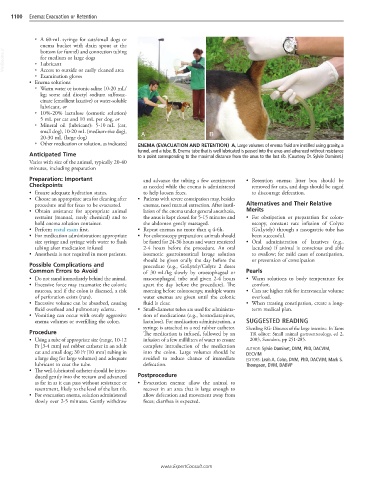Page 2211 - Cote clinical veterinary advisor dogs and cats 4th
P. 2211
1100 Enema: Evacuation or Retention
○ A 60-mL syringe for cats/small dogs or
enema bucket with drain spout at the
VetBooks.ir ○ Lubricant
bottom (or funnel) and connection tubing
for medium or large dogs
○ Access to outside or easily cleaned area
○ Examination gloves
• Enema solutions
○ Warm water or isotonic saline 10-20 mL/
kg; some add dioctyl sodium sulfosuc-
cinate (emollient laxative) or water-soluble
lubricant, or
○ 10%-20% lactulose (osmotic solution)
5 mL per cat and 10 mL per dog, or
○ Mineral oil (lubricant): 5-10 mL (cat,
small dog), 10-20 mL (medium-size dog), A B
20-30 mL (large dog)
○ Other medication or solution, as indicated
ENEMA (EVACUATION AND RETENTION) A, Large volumes of enema fluid are instilled using gravity, a
funnel, and a tube. B, Enema tube that is well lubricated is passed into the anus and advanced without resistance
Anticipated Time to a point corresponding to the maximal distance from the anus to the last rib. (Courtesy Dr. Sylvie Daminet.)
Varies with size of the animal, typically 20-40
minutes, including preparation
Preparation: Important and advance the tubing a few centimeters • Retention enema: litter box should be
Checkpoints as needed while the enema is administered removed for cats, and dogs should be caged
• Ensure adequate hydration status. to help loosen feces. to discourage defecation.
• Choose an appropriate area for cleaning after • Patients with severe constipation may, besides
procedure and for feces to be evacuated. enemas, need manual extraction. After instil- Alternatives and Their Relative
• Obtain assistance for appropriate animal lation of the enema under general anesthesia, Merits
restraint (manual, rarely chemical) and to the anus is kept closed for 5-15 minutes and • For obstipation or preparation for colon-
hold enema solution container. the abdomen gently massaged. oscopy, constant rate infusion of Colyte
• Perform rectal exam first. • Repeat enemas no more than q 4-6h. (GoLytely) through a nasogastric tube has
• For medication administration: appropriate • For colonoscopy preparation: animals should been successful.
size syringe and syringe with water to flush be fasted for 24-36 hours and water restricted • Oral administration of laxatives (e.g.,
tubing after medication infused 2-4 hours before the procedure. An oral lactulose) if animal is conscious and able
• Anesthesia is not required in most patients. isosmotic gastrointestinal lavage solution to swallow; for mild cases of constipation,
should be given orally the day before the or prevention of constipation
Possible Complications and procedure (e.g., GoLytely/Colyte 2 doses
Common Errors to Avoid of 30 mL/kg slowly by oroesophageal or Pearls
• Do not stand immediately behind the animal. nasoesophageal tube and given 2-4 hours • Warm solutions to body temperature for
• Excessive force may traumatize the colonic apart the day before the procedure). The comfort.
mucosa, and if the colon is diseased, a risk morning before colonoscopy, multiple warm • Cats are higher risk for intravascular volume
of perforation exists (rare). water enemas are given until the colonic overload.
• Excessive volume can be absorbed, causing fluid is clear. • When treating constipation, create a long-
fluid overload and pulmonary edema. • Small-diameter tubes are used for administra- term medical plan.
• Vomiting can occur with overly aggressive tion of medications (e.g., benzodiazepines,
enema volumes or overfilling the colon. lactulose). For medication administration, a SUGGESTED READING
syringe is attached to a red rubber catheter. Sherding RG: Diseases of the large intestine. In Tams
Procedure The medication is infused, followed by an TR editor: Small animal gastroenterology, ed 2,
• Using a tube of appropriate size (range, 10-12 infusion of a few milliliters of water to ensure 2003, Saunders, pp 251-285.
Fr [3-4 mm] red rubber catheter in an adult complete introduction of the medication AUTHOR: Sylvie Daminet, DVM, PhD, DACVIM,
cat and small dog; 30 Fr [10 mm] tubing in into the colon. Large volumes should be DECVIM
a large dog for large volumes) and adequate avoided to reduce chance of immediate EDITORS: Leah A. Cohn, DVM, PhD, DACVIM; Mark S.
lubricant to coat the tube. defecation. Thompson, DVM, DABVP
• The well-lubricated catheter should be intro-
duced gently into the rectum and advanced Postprocedure
as far in as it can pass without resistance or • Evacuation enema: allow the animal to
resentment, likely to the level of the last rib. recover in an area that is large enough to
• For evacuation enema, solution administered allow defecation and movement away from
slowly over 2-5 minutes. Gently withdraw feces; diarrhea is expected.
www.ExpertConsult.com

